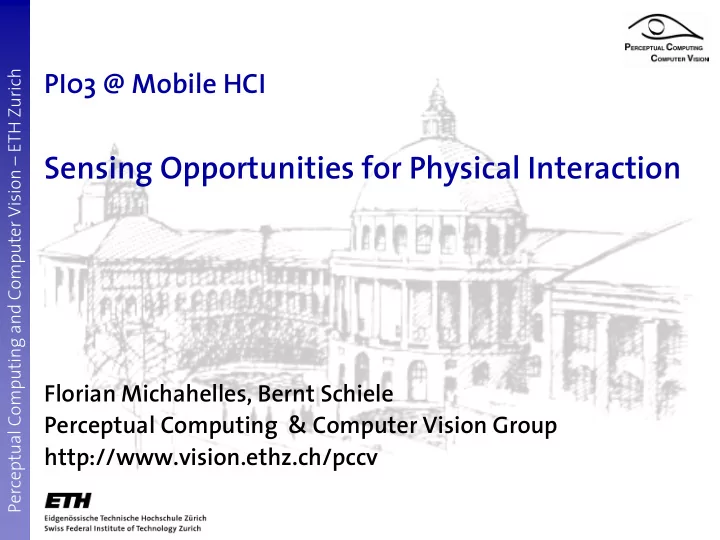

Perceptual Computing and Computer Vision – ETH Zurich PI03 @ Mobile HCI Sensing Opportunities for Physical Interaction Florian Michahelles, Bernt Schiele Perceptual Computing & Computer Vision Group http://www.vision.ethz.ch/pccv
Approaching Physical Interaction Perceptual Computing and Computer Vision – ETH Zurich • real world: natural interaction • computers: virtual interaction • integration of both worlds: Physical Interaction � devices/wearables – sensors, computing and communication � objects/environments – sensing and displaying information -> What are the appropriate sensors? 2
Perceptual Computing and Computer Vision – ETH Zurich Logical View: Dimensions of Sensing interaction degree activity ID Quality of Perception location use of objects Biometric signs 3
Physical View: Placement of Sensors Perceptual Computing and Computer Vision – ETH Zurich • in environment hidden � works with all users � often indirect � • on human obvious to user � works in all environments � direct � • on object works in objects proximity � depending on object’s properties � – present-to-hand ( vorhandensein) vs. ready-to-hand ( Zuhandensein) • mutual colloboration direct � works in instrumented environments with instrumented users � 4
Sensing Opportunities for Physical Interaction Perceptual Computing and Computer Vision – ETH Zurich present-at-hand ready-to-hand 5
Perceptual Computing and Computer Vision – ETH Zurich Discussion 6
Discussion Perceptual Computing and Computer Vision – ETH Zurich • each placement is meaningful for at least one dimension • in environment & on human: best sensing results • video & audio best suited for environment placement � computationally expensive � indirect measure • on object: mostly inertial sensors • high relevance of location in real-world � indirect measure for activity � best technology support (GPS, indoor systems…) 7
Conclusion Perceptual Computing and Computer Vision – ETH Zurich • six dimensions of sensing represent sensing goals • review of ubicomp research • first step to systematize the use of sensors • future work: � classifying combination of sensors � design space of sensors � sensor cookbook – support for application designers – sensor selection at run-time 8
Perceptual Computing and Computer Vision – ETH Zurich PI03 @ Mobile HCI Sensing Opportunities for Physical Interaction Thank you! Florian Michahelles, Bernt Schiele Perceptual Computing & Computer Vision Group http://www.vision.ethz.ch/pccv
Dimensions (cont.) accel./gyro video (face) audio Perceptual Computing and Computer Vision – ETH Zurich activity video human interaction biometrics intent - audio -group role gang gesture- sound -discussion ID posture- -conversation -fingerprint gaze- -talking -face movement pat.- -collocation -voice movement- -gate sit, stand, lie: static- -height/weight idle- -presence location use of objects –-object relations –object usage: purpose… –object features –object count –presence –in-/outdoor –direction –moved distance –relative loc. (obj.) –absolute loc. –semantic loc. light RF-ID -living subj. sound IR-proximity temp. capacity pressure touch-force -phys. measures GPS RF-ID -emotional state knowledge oximeter -state prediction galvanic skin Bio signs puls/temp. face anal. 10
Recommend
More recommend